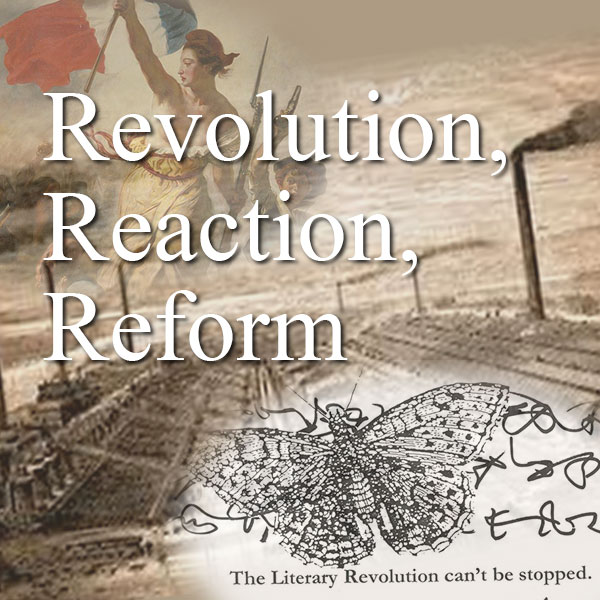MSSU ENG272 - Spring 2025 Dashboard
Description
 British Literature II: Revolution, Reaction, Reform examines British literature from the late eighteenth century to the present, a period that witnessed the American and French Revolutions, slave revolts such as the Haitian Revolution, a “revolution in female manners,” the Industrial Revolution, the twentieth-century revolutionary wave in Europe, as well as World War I and World War II, and, of course, artistic revolutions. We will consider how the authors and literary works of this period might be reacting to change, advocating for reform, or participating in literary revolutions—whether revolution is understood in the sense of “revolving” or of “revolting,” going full circle to return to a previous (more perfect?) time or experiencing/effecting a great alteration or rupture.
British Literature II: Revolution, Reaction, Reform examines British literature from the late eighteenth century to the present, a period that witnessed the American and French Revolutions, slave revolts such as the Haitian Revolution, a “revolution in female manners,” the Industrial Revolution, the twentieth-century revolutionary wave in Europe, as well as World War I and World War II, and, of course, artistic revolutions. We will consider how the authors and literary works of this period might be reacting to change, advocating for reform, or participating in literary revolutions—whether revolution is understood in the sense of “revolving” or of “revolting,” going full circle to return to a previous (more perfect?) time or experiencing/effecting a great alteration or rupture.
Access the works for annotations assignments in COVE Studio here: ENG 272, Spring 2025
The digital edition of Frankenstein for annotations and the map project can be found here: Mary Shelley, Frankenstein (1818)
Galleries, Timelines, and Maps
Individual Entries

The birthplace of Anna Letita Barbauld, Kibworth Harcourt, Leicestershire, England is located near Market Harborough and Leicester. Kibworth Harcourt is a village in the Harborough district of Leicestershire, England. It is one of two civil parishes that make up the area known as Kibworth, the other being Kibworth Beauchamp. The two are divided by the Midland Main Line.
The 1700's in Kibworth Harcourt was a rural town with a strong sense of communitity, and tradition. Farming held the economy together, and life was closely tied to the changing of the seasons: planting, harvesting, and tending to livestock. Social status in Kibworth Harcourt was often inhearitied with landowners at the top and tenant farmers following behind them. The community bonded through labor, religious observance, and traition. People relied on each other for support and cooperation.
When it...
more
Ullswater is one out of 16 major lakes in England's lake district. This river has a ribbon shaped which was formed by glaciers carving into the rock underneath while the ice melted. This lake is also the second largest and the second deepest lake in England's lake district. This lake is monitored and studied closely, and research has found that the water quality is often stable and that heavy rains can affect the level of the lake, causing it to be significantly higher at times. Of course, Ullswater also was a beloved place by William Wordsworth as the daffodils he found by this lake inspired his poem "I Wandered Lonely as a Cloud." In the past, he would also take his friends and sister walking in this area.
By writing about nature in such an admirable way, Wordsworth is choosing to write about something that brings...
more
Nagasaki is located at the mouth of the Urakami River, where it empties into the Nagasaki Harbour. This is the city in which Kazuo Ishiguro was initially born in, and the author spent his first five years of his life in the city. Nagasaki was a location in which the atom bomb has been dropped and while some of the city has been rebuilt, much of it is still in ruins from the atomic bomb. Kazuo Ishiguro himself was born after the atomic bomb's drop, but his mother and her family lived in Nagasaki when the bomb dropped. It was also the second oldest trading port in Japan after Hirado, where the Portuguese arrived and introduced Roman Catholicism and guns to the Japanese. The reason why Nagasaki had been chosen as a...
more